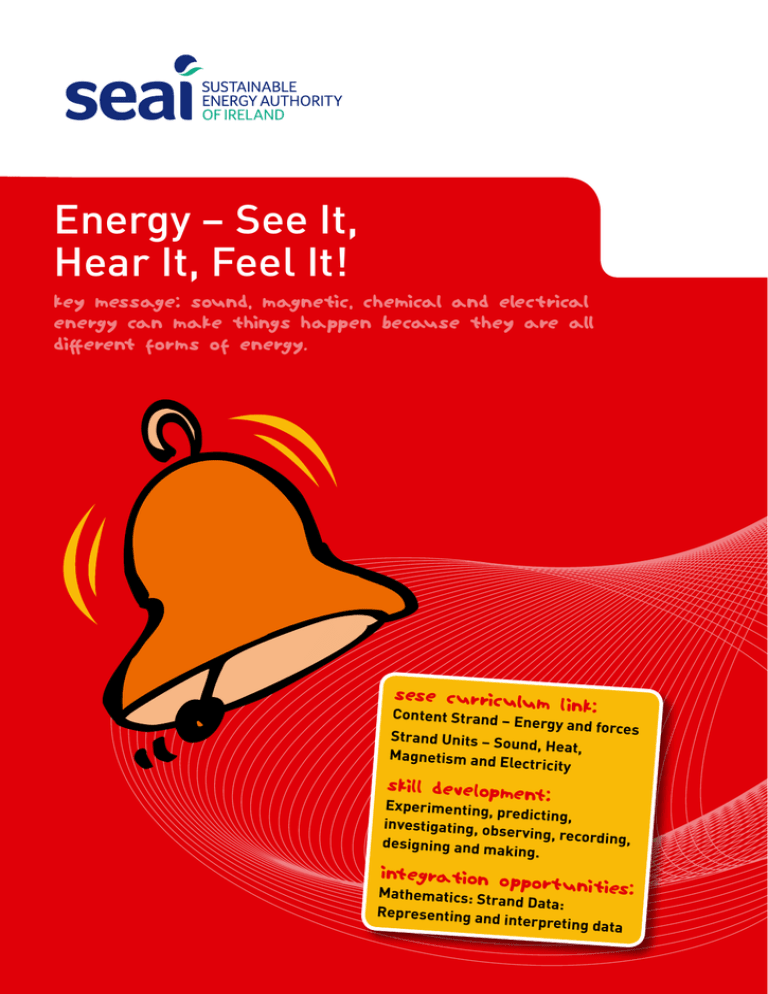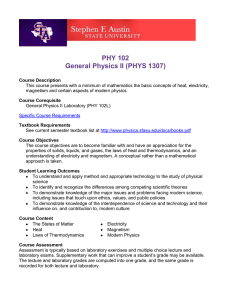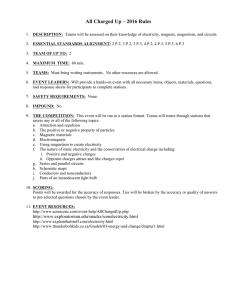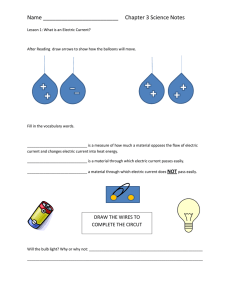Energy – See It, Hear It, Feel It!
advertisement

Energy – See It, Hear It, Feel It! Key message: Sound, magnetic, chemical and electrical energy can make things happen because they are all different forms of energy. SESE Curriculu m Link: Conte nt Strand – Ene rgy and forces Strand Units – S ound, Heat, Magnetism and Electricity sKILL DEVELOPME NT: Experimenting, predicting, investigating, ob serving, recordin g, designing and m aking. Integration Op portunities: M athematics: Str and Data: Representing an d interpreting da ta Energy – See It, Hear It, Feel It! Key Message: Sound, magnetic, chemical and electrical energy can make things happen because they are all different forms of energy. Before you start Today we are going to look at different forms of energy and how they make things happen. ((Discussion on feeling tired, the difference between what you feel like in the mornings and in the evenings, before and after a meal, what the body needs to keep going – food, drink and sleep. ((Where does energy come from? oil, petrol, gas, food ((What energy did you use today (i) before you came to school: electricity – to heat the shower, turn on light, toaster (ii) to get to school: your own, from food – walk, cycle; petrol – car, bus (iii) in school: electricity – light, heat, computers ((Where did this energy come from? Directly from a fossil fuel like a car burning petrol. Or indirectly from a socket, along a power line from a power station where fossil fuels are burned or from a wind farm. ((How do you get at this energy in order to use it? Say you have a lump of coal, a can of petrol, a bar of chocolate, what do you have to do to it in order to get the energy from it? Burn it, in the case of coal and petrol, or have a chemical reaction – what your digestive system does to the chocolate when you eat it ((How do you dry your clothes? wind, tumble dryer Background Try to draw all this together by the general idea that sound, magnetic, chemical and electrical energy can make things happen because they are all different forms of energy. When a sound is made it makes the air vibrate and these vibrations carry the sound to your ears. Magnetism is an invisible force between certain materials and can attract or repel. In the chemical activity, when water is added to the tablet it fizzes up, releasing the gas carbon dioxide. The pressure of the carbon dioxide gas builds up inside the canister until it becomes so great that it blows the canister from the lid and up into the air. Electrical energy is the energy that makes many things work, i.e. electricity which powers lights, computers, toasters and televisions. 2 Energy – See It, Hear It, Feel It! What does sound energy feel like? You will need 1 of each item per pair of students – if available Balloon Tuning fork Small bowl or container of water Steps Investigation 1 (a) 1. Put your fingers gently on your throat and say “Hi everybody”. What do you feel? Movement in your throat – this is your voice box vibrating. 2. Blow up a balloon, tie a knot in it and hold it against your ear; ask your friend to press their lips against the blown up balloon and say a few words. Then swap around. What do you notice? The vibrations of the sound. Investigation 1 (b) 1. Bang a tuning fork on a table to make it vibrate. What can you hear? Can you see the ends vibrating? 2. If not, touch the ends to the surface of some water in a container. What do you see? Sound is always caused by something moving: doors slamming, footsteps, car engines. Every movement sets up vibrations which push the air molecules nearby so that they vibrate too. These are called sound waves. It’s like when you drop a pebble in a pond, producing lots of concentric waves. 3. Ask children to record their findings on the recording sheet sound, at the end of the lesson plan. 3 Energy – See It, Hear It, Feel It! How can we see the energy of magnets? You will need 1 pair of magnets per group of children Various objects for testing e.g. wood, paper clip, plastic, coins, glass, nail, polystyrene etc. Steps 1. Hold a north pole of a magnet towards a south pole of another magnet. What happens? The magnets join together. 2. Hold a north pole of a magnet near the north pole of another magnet. What happens? The magnets push away from each other. 3. Ask a child to suspend one magnet by a string in the middle and another child to bring the other magnet up to it (see diagram below). What happens? 4. Ask the children to record their findings on the recording sheet magnetism 1. 5. What sort of things are attracted to a magnet? The children usually answer “metals”, then follow-up with the question “Do all metals stick to a magnet?” The only metals which are attracted to a magnet are iron, steel, nickel and cobalt. Allow the children to investigate with the various objects listed and record their findings in the recording sheet magnetism 2, at the end of the lesson plan. 6. Ask the children to test some other things, eg. things on their desk, in the classroom or jewellery and add the findings to the recording sheet. If the children have done some activities with magnets in first or second classes, some other objects could be added in such as plastic-coated paper clips which could give rise to further questioning and extend the theme. 7. Coins make a good topic for discussion, especially the E1 and E2 ones, with the different metals, i.e. copper, nickel and zinc. 4 Energy – See It, Hear It, Feel It! How can we see the energy of electricity and what does it do? You will need 1 bulb2 pieces of insulated (plastic-covered) electric wire Wire-cutters1 battery (voltage of battery and bulb should be fairly similar) Paper clips Cellotape Steps 1. Use the wire-cutters to peel off the plastic from both ends of the wires. 2. Take the two wires, a battery, a light bulb and bulb-holder and try to get the bulb to light. A complete circuit is needed. The wire can be connected to the battery using a paper clip and cellotape. The wiring should only touch the light bulb (see diagram below). 3. Where did the bulb get the light energy from? The chemical energy in the battery was converted into electricity which was converted into light energy. 4. Ask children to record their findings on the recording sheet electricity, at the end of the lesson plan. Do chemicals provide energy? You will need Film canister or empty, clean Yop bottle Blue tack Water Vitamin C tablet or any non-medicinal tablet which fizzes Steps 1. Break the tablet and using the blue tack, attach half of it to the inside of the lid of the canister. 2. Put water into the canister until it is about half full. 3. Close the lid. 4. Give the canister a good shake and place upside down (lid downwards) on the ground. 5. Stand back and wait! The water reacts with the tablet causing it to fizz (releases the chemical energy) and there is a build-up of gas in the film container. Gases take up lots of space so the canister is too small to contain the gas – pressure builds up and the lid pops. 6. Ask children to record their findings on the recording sheet chemicals, at the end of the lesson plan. 5 Energy – See It, Hear It, Feel It! Did you know? When lightning hit power cables in New York in 1977 nine million people were plunged into darkness, with many people trapped in lifts. Thieves looted shops and supermarkets. 426 police officers were injured in trying to keep law and order, there was chaos without electricity! The Maglev train in Japan does not touch the rails! It stays above the rails by magnetic force of repelling. North and north poles or south and south poles. It is pulled forward by magnetic force of attraction; it can go very fast – up to 345 miles per hour – because there is no friction with the rails to slow it down. Light travels a million times faster than sound which is why you hear thunder well after you see a flash of lightning, even though they both happen at the same time. Safety Care with electrical wires and children’s eyes. Care with the chemical energy investigation – ask children to stand back from the film canister. Place newspaper under the canister to avoid a mess. Discussion ((What way did your energy source behave? ((Sound: Is there any difference in what you feel when your partner speaks loudly and softly? ((Magnetism: Do magnets always pull things towards them? ((Electricity: What do you have to have in order for the bulb to light? A complete circuit. ((Chemical: How did they get the rocket to jump up higher? Did the amount of tablet or the amount of water matter? ((The children could create a bar chart showing what energy sources are used in their homes. As many homes will have more than one type of energy supply, choose certain items such as cooker, living-room heating, hot water etc. See sample bar chart on page 12. 6 Energy – See It, Hear It, Feel It! Recording sheet – photocopy and use Sound What kind of energy does sound make? Draw a diagram of your investigation on a blank sheet What we wanted to find out: What we did: First we Then we We found out that: 7 Energy – See It, Hear It, Feel It! Recording sheet – photocopy and use Magnetism 1 How can we see the energy of magnets? Draw a diagram of your investigation on a blank sheet What we wanted to find out: What we did: First we Then we We found out that: 8 Energy – See It, Hear It, Feel It! Recording sheet – photocopy and use Magnetism 2 Testing the magnetism of different objects My prediction Object Magnetic Non-magnetic Wood Cork Paper clip Plastic Coin Nail Polystyrene My result Object Magnetic Non-magnetic Wood Cork Paper clip Plastic Coin Nail Polystyrene 9 Energy – See It, Hear It, Feel It! Recording sheet – photocopy and use Electricity How can we see the energy of electricity and what does it do? Draw a diagram of your investigation on a blank sheet What we wanted to find out: What we did: First we Then we We found out that: 10 Energy – See It, Hear It, Feel It! Recording sheet – photocopy and use Chemicals Can chemicals provide energy? Draw a diagram of your investigation on a blank sheet What we wanted to find out: What we did: First we Then we We found out that: 11 Energy – See It, Hear It, Feel It! Recording sheet – photocopy and use Sample Bar Chart Energy Sources Used by the Class at Home SITTING ROOM 27 in class 8 7 7 6 5 6 5 4 4 3 3 2 2 1 0 COOKING Coal 15 Gas Wood Peat Electricity Central Heating only 14 27 in class 12 11 9 6 3 0 2 0 Coal Gas 0 0 Wood Peat Electricity Aga/ Rayburn HOT WATER 27 in class 10 10 8 6 6 5 6 4 2 0 12 Gas Oil Central Heating Central Heating Electricity Wood, Coal, Peat (Back Boiler) Energy – See It, Hear It, Feel It! Recording sheet – photocopy and use Sources of Energy In this picture there are seven sources of energy and at least five different ways in which energy is being used. Can you spot them? Answers on page 14. 13 Energy – See It, Hear It, Feel It! Answers to Sources of Energy activity are: Sun: giving light; giving heat, especially in the conservatory; ripening tomatoes in the greenhouse Wind: drying clothes on the washing line Electricity: giving electrical energy to a range of appliances in the house Coal: heating homes (see the smoke) Petrol/diesel: giving energy to car and lorry Heating oil: heating home (see central heating chimney) Food: being unloaded from car and giving energy; to keep people warm and move about (see children playing) 14


